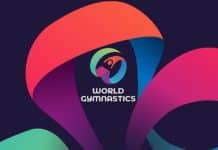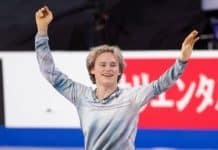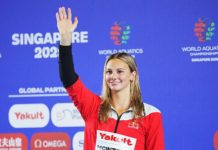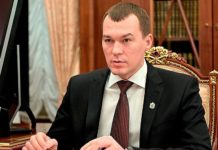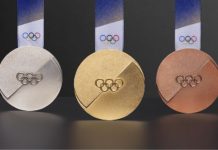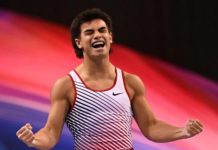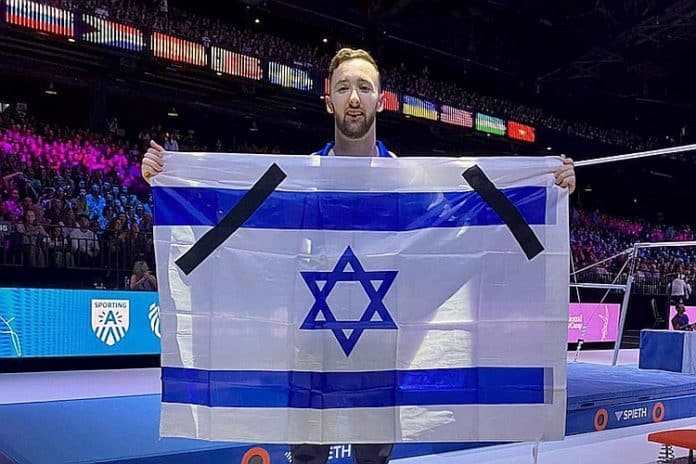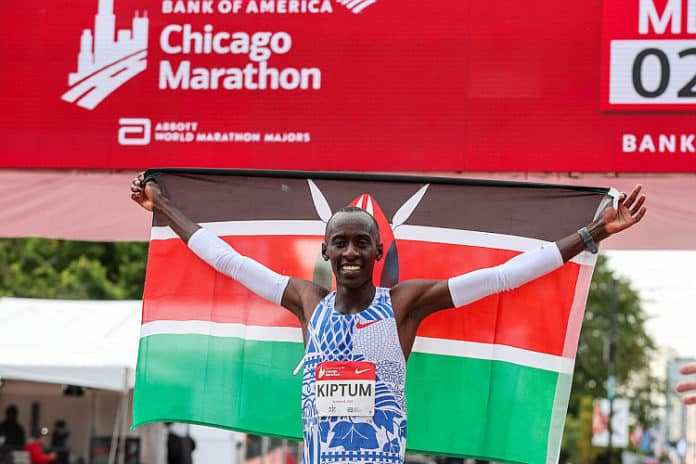★ The Sports Examiner: Chronicling the key competitive, economic and political forces shaping elite sport and the Olympic Movement.★
★ To get The Sports Examiner by e-mail: sign up here! ★
≡ THE 5-RING CIRCUS ≡
1. LA28 adds baseball, softball, cricket, flag football, lacrosse and squash
2. IOC faces new questions on Palestine and Iran after attack on Israel
3. Dolgopyat on a gymnastics gold while Israel was attacked
4. Could Hassan duplicate Zatopek’s distance triple in Paris?
5. IPC to light torch at Stoke Mandeville from 2024 on
● LA28 asks for five added sports, including baseball-softball, cricket, flag football, lacrosse and squash, bringing the sport total to 34, the most ever, with a possibility of expanding to 36 if modern pentathlon and weightlifting are added back.
● The attack by Hamas, backed by Iran, against Israel raises new questions for the International Olympic Committee. Already trying to navigate through a controversial re-admission of “neutral” Russian and Belausian athletes, what will the IOC now do about the participation of Palestine and Iran for Paris in 2024?
● Israeli gymnast Artem Dolgopyat, the Olympic Champion in men’s Floor Exercise, woke up Saturday morning, eight hours before his competition at the 2023 World Championships in Belgium, to air-raid alerts from home on his mobile phone. He somehow managed to win and collect Israel’s first-ever World Gymnastics Championships gold medal.
● Kenyan Kelvin Kiptum stole all the headlines at Sunday’s Chicago Marathon with his world-record 2:00:35 run, but could women’s winner, Dutch star Sifan Hassan, be positioned to duplicate the 1952 Olympic heroics of Czech legend Emil Zatopek in Paris next year?
● The International Paralympic Committee said that it will begin its quadrennial torch run to the Paralympic Games at Stoke Mandeville in Britain, where the concept that began the Paralympics started in 1948.
● Panorama: International Olympic Committee (Agenda 2020+5 report says Olympic Movement finances are stable) = Pan American Games (2: U.S. announces 631-member team for Santiago; USATF will send 77) = Russia (Olympic Committee head sees no reason to resign from IOC) = Memorabilia (Olympin show comes to southern California Friday) = Cycling (France’s Mahieu sweeps BMX World Cup in Argentina) ●
● Errata: Some readers of Monday’s post on the Ingrid O’Neil Auction no. 95 results saw her name misspelled in the top-of-post summary as “O’Neal.” Of course, it’s “O’Neil,” and quickly corrected. Sorry, Ingrid! ●
● Schedule: Due to a scheduling conflict, the next TSX post will be on Thursday (12th). ●
1.
LA28 adds baseball, softball, cricket, flag football, lacrosse and squash
“The LA28 Olympic and Paralympic Games shared its official proposal for new Olympic sports, including Baseball/Softball, Flag Football, Cricket (Twenty20), Lacrosse (Sixes) and Squash, to the International Olympic Committee (IOC) for potential inclusion in the 2028 Olympic sport program.”
Monday’s statement sets up the approval process for these sports at the International Olympic Committee’s Executive Board meetings this week in India and the IOC Session in Mumbai on 15-17 October.
LA28 chief executive Kathy Carter said the additions were made with no added financial risk:
“In building the Olympic sport program, we were willing to challenge the status quo and think differently about what’s possible for the Games in Los Angeles. We approached the process holistically and authentically, ensuring that our decisions were grounded in the Games’ commitment to fiscal responsibility.”
Existing venues in the Los Angeles area – there are plenty – are sure to be used for all of the added sports, with the only question about a suitable cricket facility, although a new, cricket-first venue is planned for development in Irvine, California.
Baseball was featured on and off as a demonstration until the 1984 Olympic Games in Los Angeles, where a full-fledged tournament was held at Dodger Stadium, leading to its eventual inclusion as a medal sport in 1992, through 2008. It came back as a medal sport at Tokyo 2020 and now again in 2028. Softball came in for 1996-2008 and again in Tokyo.
Cricket was played at the Paris 1900 Games, but has not been in the Games since. Those promoting cricket have said that its inclusion will provide a television rights windfall for the IOC; India pays about $20 million for TV rights, but estimates range up to $200 million more for 2028 with the sport included.
Flag Football has never been in the Games and is strongly backed by the National Football League, especially as a way to involve women in a game which almost exclusively played by men as tackle football. The NFL would be expected to help promote the sport heavily.
Lacrosse was played at the St. Louis 1904 Games and in London in 1908 and was a demonstration sport in 1928, 1932 in Los Angeles and 1948 in London. It has been chasing Olympic inclusion for decades and is popular in the eastern U.S., especially, and has expanded its national profile through the professional Premier Lacrosse League.
Squash has also been seeking Olympic status for many years and will finally be part of the Games in Los Angeles.
The LA28 program has now exploded to 34 sports, possibly on the way to 36. A list of 28 sports was approved in 2021, with boxing, modern pentathlon and weightlifting left off. When the IOC de-recognized the International Boxing Association last June, it also confirmed boxing’s place on the LA28 program. Now, five more sports are being added (34) and a decision on modern pentathlon and weightlifting are expected in Mumbai, so the LA28 total could be 36 sports.
The most sports in a single Games prior to 2028 was 33 for Tokyo 2020, but the LA28 total of 34 to 36 will be a new high.
The question of the athlete cap of 10,500 for the Olympic Games is now a significant issue, with the addition of so many more sports meaning there is potentially less room for the existing ones. However, depending on the real capacity of the residential housing at UCLA, site of the Olympic Village, some arithmetic gymnastics could be introduced, such as a cap of 10,500 athlete occupants in the Village on any individual day.
There is also the issue of rowing and canoeing housing, as the chosen Long Beach Marine Stadium facility can have significant tidal impacts that would force early-morning sessions to be held … meaning a subsidiary village could be required in Long Beach to allow a short commute to the site, instead of the 45 minutes or more from UCLA.
2.
IOC faces new questions on Palestine and Iran after attack on Israel
“Neutral” athletes from Palestine? Iran?
The International Olympic Committee now has even more headaches to deal with at its 141st Session in Mumbai, India, beginning on Sunday, in the wake of the attack on Israel from the Gaza Strip on Saturday.
The ongoing bloodshed has killed more than 1,000 and will continue for some time, making the issue of a Palestinian presence at the Paris 2024 Olympic Games a trivial issue in comparison. But the high profile of the Games ensures that the issue will arise, especially now as the IOC has nominated Yael Arad, Israel’s first-ever Olympic medal winner – in judo in 1992 – and head of the Israeli National Olympic Committee as a new member, to be confirmed in Mumbai.
Palestine has had only a modest profile at the Games, first appearing in 1996 in Atlanta; five athletes in four sports participated at Tokyo 2020.
And what of Iran, which has been widely acknowledged as a planner and overseer of the attack with its anti-Israeli proxy organizations Hamas (in Palestine) and Hezbollah (in Lebanon)? Iran has been suspended on and off for anti-Semitic activities for years and certainly bears responsibility, but will the IOC act against it, or Palestine?
And the Russian question keeps getting more difficult for the IOC, with the Russian Olympic Committee announcing last Thursday (5th) that it has “admitted as members” newly-formed sports organizations from areas of eastern Ukraine invaded by Russia that were illegally “annexed” into the Russian Federation in 2022:
“Today the Olympic councils of the Donetsk and Lugansk people’s republics, Zaporozhye and Kherson regions, as well as the Yaroslavl region have become members of the ROC.”
The Ukrainian National Olympic Committee sent a message to the IOC on Friday (6th) asking that this action be raised at the IOC’s Executive Board meeting:
“This is a gross and obvious violation of the Olympic Charter. The NOC of Ukraine requests you to bring the issue of this violation to the next meeting of the IOC Executive Committee and apply sanctions established by the Olympic Charter for such a gross violation of the principles and foundations of the Olympic movement.”
The IOC Executive Board meets on Thursday and Friday, with the Session following on Sunday.
Observed: The attack on Israel and the “admission as members” of sports organizations in occupied areas of Ukraine raise the stakes for the IOC. Its President, Thomas Bach of Germany, insists that the IOC is using sport as an instrument of peace.
He will quote the second principle of Olympism from the Olympic Charter, which reads:
“The goal of Olympism is to place sport at the service of the harmonious development of humankind, with a view to promoting a peaceful society concerned with the preservation of human dignity.”
Bach and the IOC have to answer, to new member Arad and others, how allowing athletes who are supported by aggressor states are allowed to compete in an event which is support to promote “a peaceful society.” This now includes Palestine and Iran, as well as Russia and Belarus, and if Hezbollah attacks Israel in the north, then also Lebanon must be called into question.
A Monday news release from the IOC on the impact of Bach’s Olympic Agenda 2020+5 reforms noted, “Credibility on and off the field of play is crucial to the Olympic Movement.” It’s at stake right now.
3.
Dolgopyat on a gymnastics gold while Israel was attacked
Imagine going to sleep Friday night, thinking ahead to Saturday at the FIG World Gymnastics Championships in Antwerp, Belgium, where you were going to compete for an individual world title in the men’s Floor Exercise.
Then, Tokyo Olympic Floor gold medalist Artem Dolgopyat, 26, who was born in Ukraine but moved to Israel at age 12, heard his mobile phone going crazy at 5:30 a.m. on Saturday morning. He told the Israeli On site (translation courtesy of Gymnovosti.com):
“I woke up to the sound of an [air raid] alert. I was scared. It was strange, I kept seeing there were [multiple] alerts. Then I heard that there were dead and wounded. Throughout the day, I didn’t know how to get it out of my head.
“It was clear to me that if I didn’t turn off my cell phone, I wouldn’t be able to compete. It was very difficult for me to disconnect. When I got the arena, I told myself that I have to be in the competition and that’s it.”
Israel had never won a World Gymnastics gold and Dolgopyat had already been runner-up on Floor in 2017 and 2019. The finals session began at the Sportpaleis at 2 p.m., with men’s Floor the first event. Dolgopyat started fourth, and his routine was less than hoped for, scoring 14.866, compared to his 15.200 in qualifying:
“The routine was not perfect but the landings were without major errors. I could do more and when I saw the score I thought of a medal, I didn’t know what color. During the routine, I felt it was worse than it really was. I thought it was all lost as soon as I got off the floor. I didn’t know if it would be enough for the gold. But everyone in the final had mistakes. For me, it was clear that would happen after what I went through this morning.”
As it turned out, Japan’s Kazuki Minami, who led off with a 14.666, ended up with the silver and Karimi Milad (KAZ: 14.600) got the bronze. American Fred Richard, who had scored 14.600 in qualifying was eighth at 13.200. The 2019 World Floor champ, Carlos Yulo (PHI), third in qualifying (also 14.600) was fourth at 14.500. Dolgopyat had his gold medal, for what it was now worth:
“I couldn’t celebrate. I was only thinking about the situation in Israel. I didn’t have one iota of joy at all. On my biggest day. I should have been the happiest person but I wasn’t. I heard the Israeli anthem and I had tears in my eyes, I was sad. That’s why we put black ribbons on the Israeli flag.”
Dolgopyat said later that while he had achieved his goal of wins at the Olympics, Worlds and European Championships:
“I fulfilled my dream of getting the three gold medals from the biggest competitions and I can’t process it because I can’t really be happy. It’s a different situation. It’s hard for me to think about it.”
4.
Could Hassan duplicate Zatopek’s distance triple in Paris?
The sensational world record of 2:00:35 by Kenyan Kelvin Kiptum, 23, overshadowed everything else at Sunday’s Chicago Marathon, his third win in three career marathons in fabulous times of 2:01:53, 2:01:25 and 2:00:35!
In some ways, however, 30-year-old Dutch star Sifan Hassan’s stunning win in her second career marathon was more interesting. Unlike most marathoners, Hassan runs track as well, nearly winning this year’s World Championships 10,000 m, but falling just before the finish, then winning the 1,500 m bronze (3:56.00) and the 5,000 m silver (14:54.11). She won the 5-10 combo in Tokyo in 2021 and was third in the 1,500 m.
She debuted at the marathon distance in London in April of this year, winning in 2:18:33, then came back on Sunday in Chicago to post the second-fastest time in history in 2:13:44, about two minutes slower than Ethiopian Tigst Assefa’s insane 2:11:53 in Berlin on 24 September.
Given Hassan’s versatility and outstanding finishing speed, could she consider an Olympic distance triple that has only been done once: the 5,000-10,000-Marathon triple by Czech icon Emil Zatopek in 1952? In Helsinki, Zatopek ran four races across eight days:
● 20 July: 10,000 m: 1st
● 22 July: 5,000 m heats: 3rd in heat 3
● 24 July: 5,000 m final: 1st
● 27 July: Marathon: 1st
If Hassan were to try this in Paris, her schedule would be similar, with four races across nine days and at least one rest day between each:
● 03 August: 5,000 m heats
● 06 August: 5,000 m final
● 09 August: 10,000 m
● 11 August: Marathon
Looking at the schedule for a 1,500-5,000-10,000 triple, that effort might be just as challenging, if not more so, with no more than one race a day, but racing on six days instead of four:
● 04 August: 1,500 m heats
● 08 August: 1,500 m semifinals
● 10 August: 1,500 m final
Since Zatopek, the best try at his 5-10-Marathon triple was Finn Lasse Viren in 1976 in Montreal, where he won his second straight 5-10 double and then finished fifth in the marathon.
¶
Kiptum and Hassan both had big paydays in Chicago, with both winning $100,000 for their victories, plus $50,000 each for setting the course records.
Kiptum’s world record took the men’s mark from the Berlin Marathon, at which the last eight world records had been set, back to 2003. Chicago was the site of the 1999 men’s world-record run of 2:05:42 by Khalid Khannouchi, then from Morocco (later the U.S.) and the 1984 record by Britain’s Steve Jones (2:08:05).
Chicago has also been the site of three women’s record marathons, by Paula Radcliffe (GBR) in 2002 (2:17:18), 2003 (2:15:25) and Kenyan Brigid Kosgei’s 2:14:04 in 2019.
There was also good news for the U.S. in these races, with Conner Mantz (6th: 2:07:47) and Clayton Young (7th: 2:08:00) both finishing under the men’s Olympic qualifying standard of 2:08:10. The women’s race saw seven Americans run under the Paris qualifying standard of 2:26:50: Emily Sisson (7th: 2:22:09), Molly Seidel (8th: 2:23:07), Sara Vaughn (10th: 2:23:24), Gabriella Rooker (11th: 2:24:35), Dakotah Lindwurm (12th: 2:24:40), Emma Bates (13th: 2:25:04) and Tristin van Ord (14th: 2:25:58).
5.
IPC to light torch at Stoke Mandeville from 2024 on
The International Paralympic Committee announced that it will permanently begin its torch relays for all future Paralympic Games from Stoke Mandeville (GBR), the birthplace of the Paralympic movement. Said IPC President Andrew Parsons (BRA):
“It is fitting that 75 years on from those historic first Stoke Mandeville Games and on the eve of ticket sales for the Paris 2024 Paralympic Games we are announcing that Stoke Mandeville will play an even greater role in all future editions of the Paralympic Games.
“The Paralympic Movement owes Stoke Mandeville and Sir Ludwig Guttmann a huge debt of gratitude. What started out as a small-scale sport event in 1948 at the back of a rehabilitation hospital for 16 injured war veterans has now become the world’s third biggest sport event. At the Paris 2024 Paralympic Games 4,350 exceptional athletes from 180 countries will compete in 22 sports, while a cumulative audience of 4.1 billion will watch on TV.
“Through his pioneering techniques, Sir Ludwig changed the world with sport, something that is central to the IPC today. With this new concept for the flame lighting, we want to honour the history of the Paralympic Movement but also highlight the evolution of the Paralympic Games since the first edition in Rome, Italy, in 1960.”
Dr. Guttmann, a German Jewish neurologist, left Germany in early 1939 to escape Nazi persecution of Jews and escaped via Portugal to Britain and remained there for the rest of his life. He created the spinal injuries center at the Stoke Mandeville Hospital in southeast England and looked for ways to treat his war-time patients, both physically and emotionally.
On 29 July 1948, on the day of the opening of the London 1948 Olympic Games, Guttmann organized a competition for wheelchair athletes which became known as the Stoke Mandeville Games, with 16 injured servicemen and women who competed in archery.
The Stoke Mandeville Games became the first Paralympic Games with the ninth edition held in Rome, Italy, in 1960, featuring 319 athletes from 21 countries. Since then, they have taken place every four years.
≡ PANORAMA ≡
● International Olympic Committee ● The IOC posted a statement on Monday, listing accomplishments and reforms attendant to its Olympic Agenda 2020+5 at the “midway” mark. All of the cited items have been widely reported before; perhaps the most important takeaway was the next-to-last paragraph:
“Despite the worldwide economic crisis, the IOC’s finances continue to be stable, contrary to many other international organisations. From the discussions with other potentially interested commercial partners and Olympic Games hosts, we can conclude that the economic outlook for the IOC and the Olympic Movement can be considered at least as stable.”
● Pan American Games ● The U.S. Olympic & Paralympic Committee announced its 2023 Pan American Games team on Monday, with the XIX PAG to open in Santiago (CHI) on 20 October.
As usual, it’s a massive group, with 631 total athletes competing in 43 of the 36 sports on the program. The team includes 93 U.S. Olympians, 32 Olympic medal winners and 94 returning Pan American Games medal winners.
The U.S. will be looking for Olympic qualifying spots in 10 sports: basketball (3×3), breaking, boxing, gymnastics (rhythmic and trampoline), sport climbing, field hockey (men and women), modern pentathlon, artistic swimming, team handball and water polo (men and women).
Olympic quota slots can be obtained in archery, diving, equestrian jumping, table tennis, sailing and shooting.
The youngest and oldest members on the team: 15-year-old skateboarder Paige Heyn and 57-year-old equestrian Laura Kraut.
¶
USA Track & Field announced its Pan American Games team for Santiago last Friday, with 77 athletes, with the strongest entry in the women’s hammer with 2019 World Champion DeAnna Price and 2022 World Champion Brooke Andersen.
The top men’s entries include triple jumpers Chris Benard, a two-time Olympian, and Omar Craddock (the 2019 Pan American gold medalist), two-time national champion discus thrower Sam Mattis, two-time Olympic hammer thrower Rudy Winkler and Tokyo Olympic javelinist Curtis Thompson.
● Russia ● Russian Olympic Committee President Stanislav Pozdnyakov was asked about the possibility of the ROC “leaving” the Olympic Movement altogether in view of the IOC’s sanctions that he has repeatedly criticized. His reply:
“Legally, there is no such procedure. To be honest, I don’t see the point in any drastic actions to leave or enter. We are part of a large sports system, a self-sufficient part, and we will develop in accordance with current conditions, and most importantly, the main thing is that we will not stand still, but create new conditions for development. This is a priority for us.”
● Memorabilia ● Pin traders unite! The 2023 Olympin Collectors Club 2023 Memorabilia Festival comes this week to Southern California, with the show floor open from Friday through Sunday, with free admission:
● 13 October: 10 a.m. to 5 p.m.
● 14 October: 10 a.m. to 4 p.m.
● 15 October: 10 a.m. to 3 p.m.
The show will be in the Panache Ballroom of the Hotel MdR in Marina del Rey, California and all 40 tables have been sold.
The Olympin Collectors Club show was in Colorado Springs in 2022; the club has 500-plus members in 30 countries.
● Cycling ● The fourth leg of the UCI BMX Racing World Cup was held in Santiago del Estero (ARG), with France’s Romain Mahieu taking his third and fourth wins of the season, beating teammate (and two-time World Champion) Joris Daudet by just 30.322 to 30.330 in race seven and then enjoying a slightly easier won on Sunday over American Cameron Wood by 30.054 to 30.569.
The wins continued France’s success in the seven races held this season (one was canceled due to weather): seven wins, with four for Mahieu and three for Daudet.
The women’s situation was eerily parallel: coming in, only two racers had won this season: Olympic champ Bethany Shriever (GBR: 3) and Australia’s Saya Sakakibara, with two wins.
On Saturday, Shriever eked out a close win in 32.403 for her fourth victory this season, ahead of Sakakibara (32.474) with American Felicia Stancil in third (33.233).
The Australian got even on Sunday, winning the second race in 32.077, beating Shriever (32.424) and France’s Axelle Etienne. Alise Willoughby of the U.S. was fifth (33.460).
The season will finish next week with two more races at Santiago del Estero.
¶
You can receive our exclusive TSX Report by e-mail by clicking here. You can also refer a friend by clicking here, and can donate here to keep this site going.
For our updated, 787-event International Sports Calendar (no. 3) for 2023 and beyond, by date and by sport, click here!









